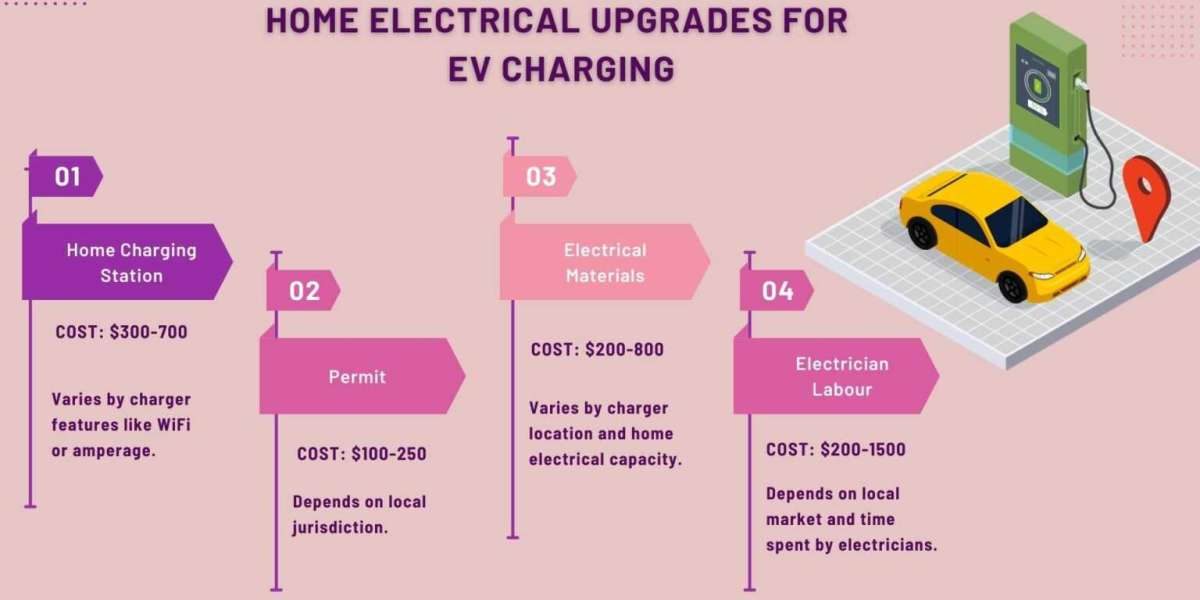Electric vehicles (EVs) are becoming more and more popular as environmentally-conscious drivers look for alternatives to gas-powered cars. As EV ownership rises, many homeowners find themselves needing to upgrade their electrical systems to install EV charging stations. This guide will overview everything you need to know about home electrical upgrades for EV charging.
We’ll start by explaining the different levels of EV charging and the electrical requirements for each. Then, we’ll cover the details of the necessary home electrical system upgrades to provide adequate capacity for powering EVs. Our goal is to equip you with the key information to successfully upgrade your electrical service for EV charging.
EV Charging Levels and Electrical Requirements
Not all EV chargers are the same. Charging stations fall into three main levels—Level 1, Level 2, and DC Fast Charging. Each has different electrical needs. Understanding the specifications of each level will help determine the required electrical upgrades.
Level 1 Chargers
Level 1 EV chargers are the most basic and slowest charging solution. They are made to be used with a standard 120-volt three-prong household outlet. This delivers an alternating current (AC) to the EV battery.
Here are the key details on Level 1 EV chargers:
- Voltage: 120V AC
- Max Amperage: 12-16A
- Charging Speed: 2-5 miles of range per 1 hour of charging
- Max Power: 1.9 kilowatts
Level 1 uses the SAE J1772 connector and draws up to 1.9 kilowatts. It is the slowest charging option, providing only 2-5 miles per hour. This makes Level 1 impractical for daily use for many EV owners. However, it can be useful as an emergency backup or for plug-in hybrids with short electric ranges.
The main downside of Level 1 is the slower charging speed. It can take 40-50+ hours to charge an electric vehicle (BEV) to 80% from empty. For plug-in hybrids (PHEVs), it takes 5-6 hours. In contrast, a Level 2 charger can charge a BEV in 4-10 hours and a PHEV in 1-2 hours. Level 3 (DC fast charging) is even faster.
Level 1 chargers usually come with the EV and plug into a standard outlet. They work best for light daily EV use and overnight charging. Level 1 is affordable and easy to install but is not ideal for frequent or long trips.
Level 2 Chargers
Level 2 EV chargers are faster and need 240-volt electricity. Most homeowners installing EV charging choose Level 2.
Here are the specifications for Level 2 EV chargers:
- Voltage: 208-240V AC
- Circuit Amperage: Up to 80A
- Max Charging Power: 19.2 kW
- Charging Speed: Up to 25 miles of range per hour
- Connector: J1772 or Tesla
Compared to Level 1, a Level 2 EV charger offers much faster charging, up to 25 miles per hour. However, to provide the 240V current, Level 2 requires dedicated circuit wiring and electrical capacity upgrades.
DC Fast Chargers
The fastest EV charging is DC fast charging. As the name suggests, DC fast chargers deliver direct current (DC) electricity directly to the EV battery. This allows them to provide up to 400V, but is not compatible with home charging.
Here are the key specifications for DC fast charging:
- Voltage: 400V+ DC
- Max Power: Up to 350 kW
- Charging Speed: Up to 200 miles in 15 minutes
- Connectors: CCS, CHAdeMO, Tesla
DC fast charging, also called Level 3, is the fastest public EV charging available. However, it needs high-capacity commercial electrical connections and is not designed for home use.
Costs of Installing a Home EV Charger

Electrical Upgrades for Level 1 Chargers
Installing a Level 1 EV charger at home is simple since it uses a regular 120V outlet. However, there are still some best practices:
Dedicated Outlet
Even though a Level 1 charger only draws 12-16 amps, it’s recommended to install a dedicated outlet, not use shared outlets. This prevents overloading circuits. Install a dedicated NEMA 5-15 outlet near where you park the EV.
Outlet Location
Level 1 cords are 18-25 feet long. Choose an outlet location within reach of where you park the EV to prevent tripping hazards.
GFCI Protection
Installing a ground-fault circuit interrupter (GFCI) outlet adds safety. GFCIs have built-in breakers that trip quickly if electricity flows outside the circuit path.
Inspect Existing Wiring
Have an electrician inspect existing wiring before using outlets for EV charging. Old degraded wiring may need replacement to safely support EV loads.
Check Electrical Panel Capacity
Verify your main electrical panel has enough capacity for the added EV load. With a 60-100 amp main service panel, capacity is usually not an issue for Level 1. But if your home has a smaller or outdated panel, an upgrade may be required.
Electrical Upgrades for Level 2 Chargers
Upgrading to a Level 2 EV charger provides faster charging and convenience. However, some electrical upgrades may be needed:
Electrical Panel Upgrade
A new or upgraded panel may be required to handle the increased electrical load from a Level 2 charger. This maintains safety and quality.
Dedicated Circuit
Level 2 chargers need a dedicated 40-100 amp circuit, installed to National Electrical Code standards by an electrician. The required amperage depends on the charger specifications.
Utility Service Upgrade
In some cases, a utility service upgrade is needed to provide the electrical capacity for a Level 2 EV charger. This involves working with your utility to ensure sufficient power.
Charger Specifications
Level 2 uses 208-240V power and can draw up to 80 amps. Most home chargers use lower amperages, like 30 amps. Consider your home’s capacity when selecting a charger.
Faster Charging Speeds
Level 2 can charge at 6.2-19.2 kW for faster charging than Level 1. This allows charging an electric vehicle (BEV) to 80% in 4-10 hours or a plug-in hybrid (PHEV) in 1-2 hours.
Permits for EV Charger Installation
Research and Plan: First things first – do your research. Develop a clear plan for where you want to install the charger and what type of equipment you’ll need based on your vehicle. Determine if any electrical upgrades are required.
Contact Local Offices: Now it’s time to contact your local officials. Speak to the planning or sustainability department to understand the specific rules for charger installations in your city or county. Permit requirements can vary from place to place.
Apply for Your Permit: With your project details in hand, apply for your permit. You may need to provide designs or load calculations, so consider hiring a licensed electrician to help with the application.
Wait for Permit Approval: Once submitted, just sit back and wait for a response. The review process can take some time as they ensure your plans comply with all applicable codes.
Install the EV Charging Station: With Installation approval in hand, you’re cleared for the installation of your EV charging station! Follow the permitted plans exactly and any additional safety instructions.
And finally, remember that ongoing charger maintenance is on you. Make sure to use and care for it properly according to your permit conditions.
Take Away
In summary, upgrading your home’s electrical service for EV charging requires considering the charger’s voltage and amperage needs, installing new dedicated circuits and panels, and working with electricians to ensure a code-compliant installation. The investment in electrical upgrades will pay off with the benefits of convenient at-home EV charging for years to come.








